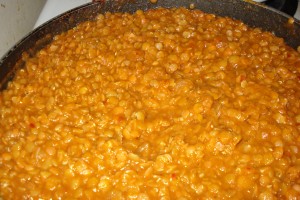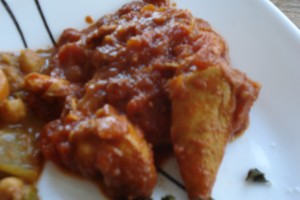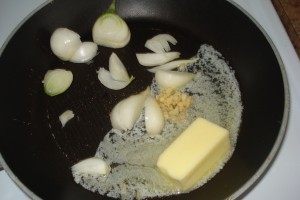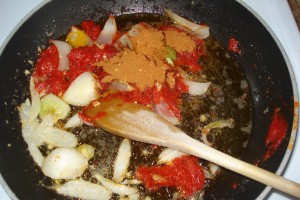For all of my zeal over curry cookery, it is perhaps strange that I had never attempted a lentil dish. Indian cuisine has no shortage of dals (i.e. curry-like amalgams of pulses cooked with spices), but I have never found myself especially excited when I’ve tried them on the buffet. It is surprising, when I consider how much I love black beans and hummus and other such legume-centric foods. Sabrina mentioned recently that whenever she eats a dal on the India Buffet, she thinks that she ought to try making lentils, and I recently had some lentils at Abay that I enjoyed… though, to be fair, I enjoy pretty much everything I eat at Abay.
Two Sundays ago, I was making a rehash of the African Peanut Curry I posted recently, and with all this talk of lentils fresh in my mind, I couldn’t help thinking that a lentil dish would make a good compliment, being easy and cheap, and it would give me an opportunity to attempt making a more complex berbere (see previous link for more discussion of berbere and its complications).
I had to do a bit of grocery shopping to get started, and so a brief excursion to the Giant Eagle ensued. I seemed to recall a sector of one aisle in the Giant Eagle with bags upon bags of different dried beans and lentils; I had never really shopped there myself, as I prefer to get my garbanzos and other beans canned, yet surely, I thought, many varieties of lentil would await me there. Well, it turned out they had only two varieties of lentil, regular brown and split green. But all the recipes I’d found for Mesir Wat called for red lentils? Surely such a thing must be had at the Giant Eagle? Looking further in the imported foods aisle, I was also surprised not to find red lentils among the Goya products, but lo and behold, there was a bag of red lentils further down the aisle among the Middle Eastern imports. $3.75. That price might not seem terrible on its own, but considering that the same amount of brown lentils (a 1 pound bag) was only a dollar and change, paying upwards of four bucks for red lentils seemed like overkill. Surely, using brown lentils wouldn’t make that much difference, right?
I went home, looked up some berbere recipes and got to work. I will readily admit that my efforts toward a more complex berbere were not as conscientious as they could have been that day. Nearly every recipe I found for berbere that included more than four or five ingredients (I believe a simpler berbere also has its utility in my spice cabinet) listed fenugreek among the seasonings. I am not a huge fan of fenugreek seed; I do have it in my vast spice collection, but I find it a little too pungent and it does not seem to me to add much in terms of pleasant flavor to dishes where I’ve used it. Methi leaves (the product of a sprouted fenugreek seed) on the other hand, I am more than willing to use and keep a stock of it specifically for my oft-made saag recipe, but I fail to see redeeming qualities in fenugreek seed. Still, I was willing to use it in my berbere for the sake of authenticity, but I couldn’t find it easily (my spice collection is vast and usually in an advanced state of disorganization), and so in a “screw it” moment decided to move forward through the recipe without it. Further down the list of berbere spices, I ran into another roadblock when I also couldn’t find my nutmeg and realized that I don’t have allspice and never did. I substituted mace and a big of pumpkin pie spice. Shrug? There was always a chance it might turn out to be the best berbere ever, right?
Well, it wasn’t the best ever. It wasn’t the worst either. My first attempt at Mesir Wat, using the brown lentils and the cobbled-together berbere was okay. I didn’t mind eating it, but it wasn’t a flavor combination I found myself anxious to make again. And yet, I did not want to give up on lentils; I knew that I had done a half-assed job of the recipe to begin with, so I took to the internet in search of greater authenticity.
One of the better resources I’ve found, oddly enough, for obtaining harder-to-find culinary items at lower prices is Amazon. My first aim was to find red lentils. There were quite a number of good choices, including one that works out to $1.73 a pound (i.e. the size of a standard grocery package), but I opted for a deal that had eight 1 lb. packages for about $18 (i.e. $2.25 a pound), as I didn’t want to commit to an enormous supply of red lentils until I saw if I would actually use them.
Secondly, I did a search for berbere. If Sabrina couldn’t come up with a good berbere on her own, and I couldn’t come up with a good berbere on my own, maybe it was time to use a pre-packaged mix. I have come to favor making my own spice mixes for a variety of reasons. It ensures consistency within my kitchen. I know exactly what’s in my recipes and I know it will come out the same every time. I don’t have to worry that the spice mix I’m using becomes discontinued or is dropped by available vendors, then I’m forced to find a different mix, and inevitably my recipes come out differently. This is why I make my own garam masala; every time I try to use a different version of this spice mix, it seems like there’s always something in it I don’t like or expect. One I tried had way too much hing, another was much too heavy on cloves and anise.
Berbere seemed a promising exception, however, as we were suffering from the opposite problem. The berbere mixes we managed to come up with seemed to be lacking important flavors that we could not uncover. For all its mystery, a pre-packaged mix might be just what we needed. In looking for a berbere online, I wanted something relatively inexpensive, but also something in a smaller package; just in case the berbere had a large proportion of some spice I found particularly offensive, I didn’t want to have to commit to buying it in bulk. I was lucky enough to find a 2 oz shaker of Ajika Berbere for $2.72 (unfortunately, it has since jumped in price, only a week later, which is the great downside of Amazon, and one of the reasons I was hesitant to use a pre-packaged spice mix in the first place).
Armed with two remedies to my last attempt at Mesir Wat, I was ready to try again. Here is the recipe I used:
MESIR WAT
 1 medium onion, chopped
1 medium onion, chopped
2-3 teaspoons garlic, minced
3 tablespoons vegetable oil or bacon fat
3 tablespoons bebere seasoning
2 cups red lentils
2 cups beef stock, or veggie stock
1 (6oz) can tomato paste
extra water, as needed
Saute the onions and garlic in the fat until onions are softened. If you don’t save bacon fat to keep on hand, simply cut up some bacon into small pieces and fry it up and leave the bacon in pan. The presence of bacon only makes things taste better, right? Add berbere and simmer on low heat for 20 minutes, adding about 1/4 cup water as needed to keep contents of skillet or pan from getting too dried out and burning. Add lentils, stock and tomato paste. Simmer covered on low until the lentils are cooked and liquid is absorbed. Additional water can be added if lentils need to cook longer to desired doneness. Serve with rice and/or flat bread.
Twenty minutes for simmering the spices did seem a little long to me; usually I abbreviate such instructions, but since my first attempt at this dish turned out underwhelming, I decided to follow the base recipe I was using more to the letter than I had before. Frying spices does change their flavor, usually by increasing intensity, so I was game to try it, and the recipe turned out very well, so I’m sticking with the 20 minute instruction.
The unfortunate thing is that I cannot stick with the berbere I found and bought on Amazon. I thought I had finally found a good, cheap, convenient spice mix for Ethiopian… but when I went online to find the link so I could include it in this blog, I found that the price of the 2 oz. bottle of berbere had jumped to $9.62. Really? Almost ten dollars for a spice they offered at three dollars only a week before? I understand that markets change and food prices increase or decrease depending on a number of factors, but the mystery of Amazon’s fast and dramatic price fluctuations eludes me. The spice mix might have been tasty, but it isn’t worth the absurdity of paying ten dollars for a tiny amount.
I am now back to my initial conundrum: Where to find a good berbere? Do I hazard to purchase another pre-packaged mix and risk either hating it… or liking it only to have the price or availability change? Do I go back to my own spice cabinet and try to assemble a worthy berbere on my own? Either way, it’s back to the drawing board with berbere!








